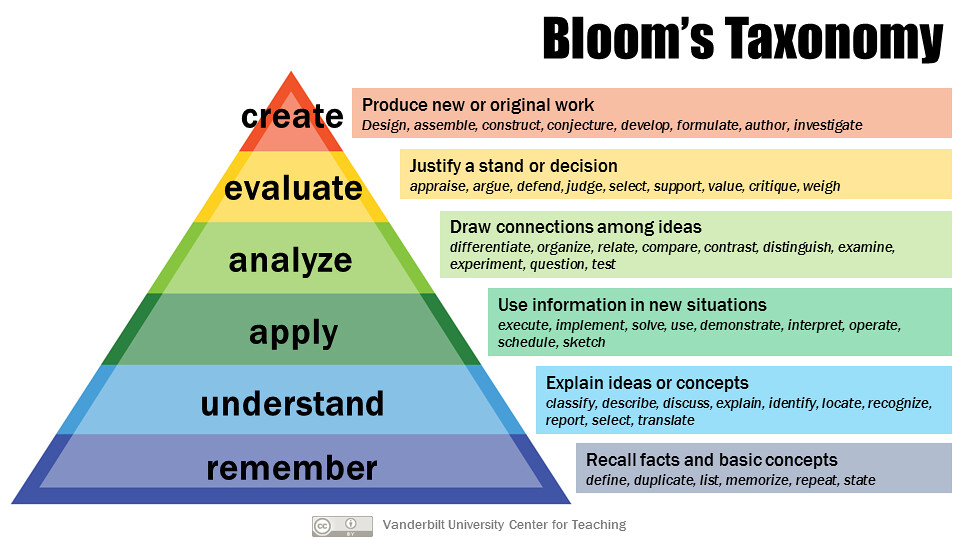For decades, professional educators have referred to Bloom’s Taxonomy to design courses and assess student growth. In a nutshell, Bloom’s Taxonomy is a framework for classifying levels of learning, with each of the successive 6 levels indicating greater mastery of a particular subject. While this tool will be familiar to most people whose profession is training or educating others, there are few outside of these fields who have ever heard of Bloom’s Taxonomy, much less apply it to the day-to-day adventure of raising children. I consider that to be a missed opportunity.
Around the house (and sadly, in many classrooms) our instruction to learners tends to come to a halt at the 3rd level of Bloom’s, that being the ability to apply knowledge. We teach our children the steps or materials needed to perform a task (step one), we make certain the child understands the procedure (step two), and we step back to see that the child is able to apply the knowledge (step three). But what about three steps that proceed from there? Those are the steps which really open a child’s mind and enable connections which we as parents might never imagine.

Table of Contents
Wash the dishes and expand your horizons
What if we were to apply a Bloom’s mindset to the simple task of hand-washing dishes? The journey might be something like this:
- Remembering: “OK kid, we need dish soap, a scrub sponge and hot water. Got it?”
- Understanding: “Now, what you’re gonna do is apply some soap to the sponge, rinse the dish in the water and then scrub the dish with soapy sponge until it’s eye-clean. Then you’ll have to rinse the soap off of the dish.”
- Applying: “Right, let’s see you wash a dish!”
So far, so good. That’s all you really need to teach to raise a helpful family member, but what if you encouraged them delve deeper and go farther?
- Analysing: “I wonder… does the water really need to be so hot? Do we need this much soap, or do we need soap at all?”
- Evaluating: “Hmmm, it seems the hot water loosens and lifts food grime better than cold, and it probably disinfects better too. Soap seems to break up grease and oil, and is also a component in disinfection.”
- Creating: “Hey, since dish soap is good against grease, I bet if I use it to wash up after working on my bike I’d get cleaner hands! I wonder how else I could use the properties of dish soap or hot water?”
Can you envision how the above scenario might lead to a discussion and interest in biology, chemistry or even materials engineering?

How Bloomin’ easy is it?
Bringing Bloom’s into your home and to bear on the intellectual growth of children doesn’t necessitate turning every interaction into a study course. Simple questions that strengthen knowledge and inspire creative thinking can be naturally peppered into your communications with your children.
Examples of questions for Remembering
- How many…?
- What is…?
- Can you name …?
- Describe what happens after…
Examples of questions for Understanding
- How would you explain…?
- What happens next?
- Can you clarify…?
- Can you illustrate…?
Examples of questions for Applying
- Which factors would you change if…?
- Do you know of another instance where…?
- Can you demonstrate…?
Examples of questions for Analysing
- If…happened, what might the ending have been?
- How is…similar to…?
- Why did…changes occur?
- Can you explain what must have happened when…?
Examples of questions for Evaluating
- How effective are. ..?
- Why is ….of value?
- What are the consequences..?
- Do you think…is a good or bad thing?
- How would you have handled…?
Examples of questions for Creating
- How many ways can you…?
- Can you design a…to…?
- Can you create a new use for…?
- Can you see a possible solution to…?
References
https://www.thinglink.com/scene/552936068828102656
https://www.celt.iastate.edu/teaching/effective-teaching-practices/revised-blooms-taxonomy/
http://www2.utar.edu.my/fegt/file/Revised_Blooms_Info.pdf


Leave a Reply